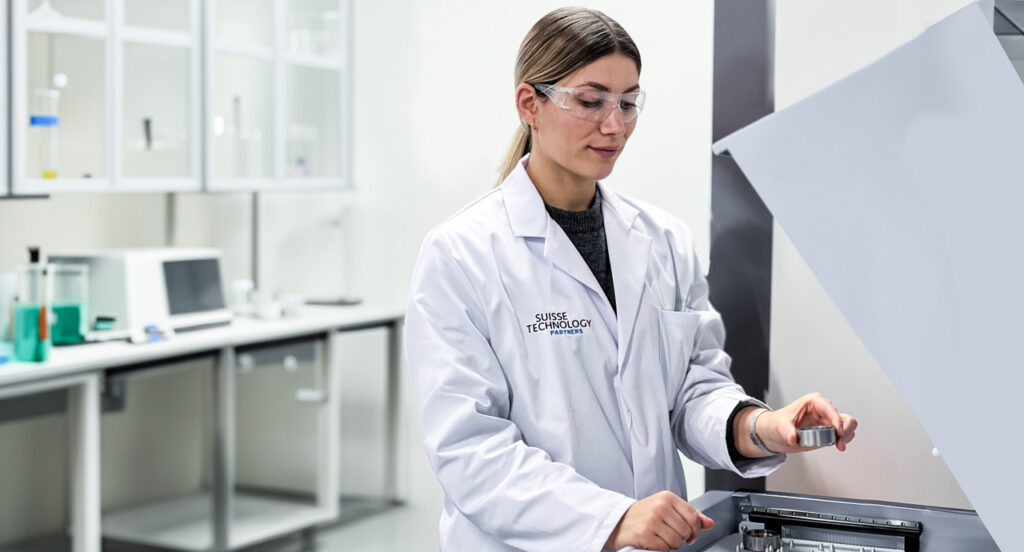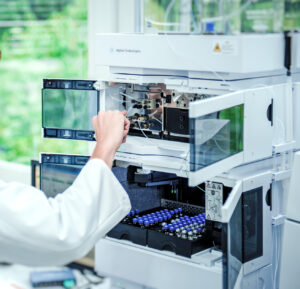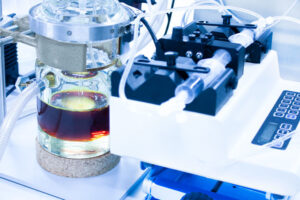XRF analysis – X-ray fluorescence
X-ray fluorescence analysis, or XRF analysis for short, is a non-destructive method for analyzing chemical elemental composition. This method is therefore also often used in elemental analysis. The energy or wavelength of the X-ray quantum is very characteristic of the element. This is the basis for determining chemical elements using X-ray fluorescence analysis. The concentrations of the elements are analyzed independently of their chemical bond.
We deliver precise, efficient and reliable analysis results, and also understand the importance of compliance with regulatory requirements / specifications. By working closely with our customers, we ensure that their products not only meet regulatory requirements, but also the highest quality standards.
Our areas of focus
Determining the elemental composition of samples that are difficult to break down
XRF analysis offers the major advantage of being able to analyze solids directly. This makes XRF analysis the preferred analytical technique for samples that are difficult to break down, such as mineral samples, ceramics or unknown mixtures of substances.
There are various methods of sample preparation:
- direct measurement on the solid sample
- production of powder compacts
- pouring powder samples onto thin foils
- production of fused beads
The most suitable sample preparation method is selected depending on the type of sample, the desired precision and the expectations regarding the samples (e.g. trace impurities).
Determination of thin pretreatment layers on aluminum
Thin layers on aluminum are difficult to determine using wet chemistry. XRF analysis offers a simple way to directly determine layer weights, e.g. of chromate layers or Ti/Zr pretreatments. To ensure the accuracy of the analyses, well-characterized calibration standards must be available. We are an accredited manufacturer of reference materials according to 17034, so we know what we are talking about.
Determination of thin PVD coatings on plastics
XRF analysis is ideal for determining thin PVD layers on plastics, e.g. SiOx, Al2O3, and metallic layers. After calibration with plastic films with a known layer weight of the PVD coating, many samples can be analyzed in a short time, e.g. in the quality control of barrier layers on plastic packaging films.
Semi-quantitative screen analysis of unknown mixtures
Semi-quantitative screen analysis of unknown material mixtures using XRF offers a fast analytical technique for rough elemental overview analysis. It often helps the customer to receive the approximate composition of a sample, e.g. deposits in a treatment bath or a production machine. With this information, it is then possible to search for the cause and often solve the problem quickly and in a targeted manner.
alloy analysis
Our expertise in X-ray fluorescence analysis (XRF) is particularly valuable for the identification of metal alloys. Supplemented by techniques such as ICP-MS, ICP-OES and spark spectrometry, we offer comprehensive solutions for element determination in various alloys. Was the correct material used? Are there any alloy impurities that could adversely affect the component properties? These analysis options have a wide range of applications in industries such as metal processing, aerospace and automotive engineering.
quality control
With XRF, we offer a fast, accurate and non-destructive method for checking the composition and purity of raw materials and finished products. This technique is particularly important for industries where compliance with specific material standards is critical. Our XRF analyses not only help companies ensure product conformity, but also optimize their manufacturing processes and avoid costly product defects.
Unsure whether RFA is the right method?
| investigation method | X-ray fluorescence analysis |
| Kurzzeichen | RFA |
| Device type and equipment | Bruker S2 PUMA |
| functional principle | The sample surface is excited with X-rays to a depth of a few µm. The element-specific X-rays (fluorescence) emitted by the elements as a result are used for the quantitative analysis of the sample. |
| Typical applications | Analysis of elements with atomic number 11 (sodium) to 92 (uranium). Analysis of metals, rocks, ceramics, mineral fillers in plastics. Layer thickness determination possible. |
| detection limit | typically 100 µg/g (element dependent) |
| Requirements for sample | quantitative: 1g qualitative: 10mg solid or liquid ideal: in powder form |
| Accreditation / Certification | ISO9001 |
Methods that might also interest you
An overview of further methods from various fields of chemical analysis:




